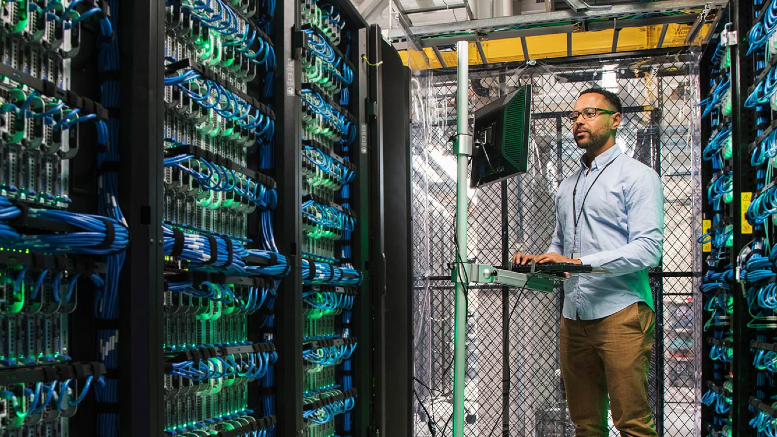Data center: Balancing cooling demands and community concerns
September 9, 2025 / Unisys Corporation
Short on time? Read the key takeaways:
- Data centers and communities can both thrive when operators choose smart cooling strategies that balance AI performance with resource responsibility.
- Even "air-cooled" data centers consume massive amounts of water through evaporative cooling systems. Meta's Georgia facility uses 500,000 gallons daily, according to a New York Times article.
- Modern liquid cooling systems flip this equation, using closed-loop designs that dramatically reduce water consumption while boosting AI performance.
- Proactive maintenance and the right service partnership transform cooling complexity into a competitive advantage while building community trust.
Can data centers and communities both win? Absolutely. Smart operators are proving every day that you can power AI ambitions while being a good neighbor, but it takes the right approach to cooling infrastructure.
A recent New York Times article brought this challenge into sharp focus. In New County, Georgia, data centers like Meta’s $750 million facility can use 500,000 gallons of water per day to cool the computers that power AI’s development and social networks. Newer AI-focused data centers may require millions of gallons daily. The impact? Residents living just 1,000 feet from the facility have already started to experience slow water pressure, residue buildup and dry taps, while the broader community may face rising water costs and potential shortages.
Unisys Solutions Director Vivek Swaminathan sees opportunity where others see obstacles. In his work helping organizations power their AI ambitions, he emphasizes the great potential to minimize data centers’ water usage through liquid cooling over more water-intensive methods. He recently shared his perspectives on this crucial topic, revealing how thoughtful cooling strategies create wins for everyone involved, protecting local water resources while delivering superior performance for demanding AI workloads.
Even “air-cooled” data centers use water
The details of data center cooling may surprise those who think of it as "air cooling," according to Vivek. In reality, most large-scale data centers, like Meta’s in Newton County, rely on water and fans to prevent their powerful computers from overheating. Even “air-cooled” facilities use water for more efficient cooling, especially in hot or humid climates and often use a system called “evaporative cooling.” This process involves spraying or passing water over special pads or coils, cooling the air as the water evaporates.
“That’s why a data center can consume hundreds of thousands of gallons a day, even if it’s technically air cooled,” Vivek explains. “It’s a trade-off: using water helps save electricity and avoid climate-warming emissions, but it can cause serious stress on local supplies, especially in communities that depend on well water.”
The good news? Modern liquid cooling systems flip this equation. Closed-loop designs recirculate coolant directly to heat-generating components, dramatically reducing water consumption while delivering superior performance for AI workloads that generate intense heat.
Proactive maintenance should be a priority
AI workloads push traditional air-cooling systems beyond their limits, which is exactly why many data centers turn to liquid cooling for high-performance AI infrastructure. However, making that switch introduces new maintenance requirements.
Liquid cooling systems use pumps, pipes, cold plates, and sometimes tanks of special fluids, all of which need regular care. Proactive maintenance is crucial because this equipment runs alongside your expensive electronics. A small leak or an unnoticed pump fault can lead to overheating, server shutdowns or equipment damage. Taking a few steps can keep you on top of this maintenance:
- Conduct regular inspections — checking for signs of leaks, monitoring coolant quality, replacing worn seals and keeping an eye on pump performance — to catch minor issues early, long before they threaten uptime or damage equipment.
- Cultivate a “watchful” culture, training staff to notice early warning signs and act on small changes.
- Partner with experts for periodic thorough reviews and specialized training to spot leaks, check coolant quality and safely perform repairs.
Minimizing community impact is possible
Modern cooling systems, like closed-loop liquid cooling or air-side economization, use less water or even no water (in the case of self-sustaining OEM units) for less money. A Data Centre Review article by Vivek explored how liquid cooling systems can reduce data center costs. Being proactive about new technology and water sources also gives you resilience if there are future restrictions.
Other ways to address data center impact include:
- Choose alternative sources like recycled or non-potable water instead of relying on municipal supplies needed by households.
- Maintain transparency about your data centers by openly monitoring and sharing current water use data and improvement plans with local governments and residents.
- Diversify and reduce water use to address community data center water usage concerns.
- Partner with local stakeholders on conservation efforts, replenish local water sources and support infrastructure upgrades that benefit everyone.
- Strengthen community relationships by attending meetings, joining stewardship initiatives and sponsoring local water sustainability projects.
Unisys guides clients in these tasks. Ultimately, “balancing the demands of a growing data center with being a good neighbor goes beyond technology to building trust and showing genuine care for the local community,” Vivek says. “We work with clients to assess their environmental impact transparently and look beyond short-term fixes.”
Setting clear sustainability targets and tracking progress publicly amplifies this approach. When neighbors see a data center operator taking concrete steps to protect local resources, it builds lasting partnerships that benefit everyone.
The right partner can add immense value
For data center operators interested in moving to liquid cooling, the right service partner can be an invaluable asset. Here’s what to look for:
- Proven experience: Prioritize partners with a strong track record of designing, installing and maintaining liquid cooling systems, especially in high-density, mission-critical environments.
- Comprehensive support: Seek partners that offer end-to-end services: from initial site assessments and system design, through installation, integration with existing infrastructure, ongoing monitoring and emergency response. This means less risk of patchwork solutions and smoother upgrades.
- Training and knowledge transfer: Understand that an ideal partner is willing to train your staff, from basics on system operation to best practices on leak detection and maintenance. Ongoing educational support turns service vendors into collaborators, not just contractors.
- Vendor neutrality: Look for partners not tied to a single hardware or fluid vendor for greater flexibility in recommending solutions aligned with your specific needs and future goals.
- Safety and compliance: Ensure the partner understands regulatory, safety and environmental requirements. They should help you select safe, compliant, sustainable coolants for your region.
- Responsiveness and service-level agreements (SLAs): Know that a partner’s value shows most during emergencies. Clear SLAs and rapid response times can make the difference between a minor blip and a costly outage.
Choosing a knowledgeable, proactive and communicative service partner reduces risk, supports operational continuity and helps your team confidently climb the liquid cooling learning curve.
Gain expert guidance from Unisys on data center initiatives
Unisys can be that valued partner in tackling your data center challenges. Discover how Unisys' field services and support solutions can help implement and maintain advanced cooling systems that extend GPU lifespan and realize AI's full potential.




















